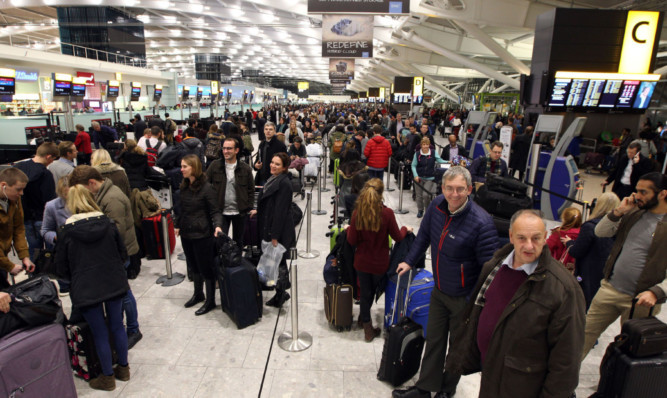
Jet-setters are routinely being delayed by more than three hours opening the door for thousands of passengers to claim hundreds of pounds in compensation.
A survey of air travellers found more than a third had faced delays flying in and out of UK airports in the last two years.
Shockingly, one in five of those were forced to endure a boredom-inducing three-hour wait. Yet just 38% claimed the compensation due to them.
Under rules introduced a decade ago, airlines have to cough up if flights are delayed for at least three hours, depending on the cause of the postponement.
Jill Starley-Grainger, travel editor of Which?, insisted passengers made late by shoddy organisation had every right to claim their money back.
She said: “Nobody wants to be held up by flight delays so airlines must do everything in their power to ensure they fly on time.
“If you’ve suffered a delay of more than three hours you could be entitled to compensation.”
Passengers hit by delays or cancellations can claim between £200 and £480 compensation, depending on how bad it was.
That’s unless the airline is able to demonstrate the problem was due to “extraordinary circumstances” such as severe weather or a security scare. In those circumstances they don’t have to pay out.
The Which? poll surveyed 7,700 people about their experiences flying in the last two years.
More than 1,500 said they’d been kept waiting more than three hours but only a small proportion claimed the compensation they would have been entitled to.
Gill Coombes, 40, who left Edinburgh to go skiing in Austria, said busier skies equal longer delays.
She said: “It’s inevitable as air travel grows that so too will the delays.
“I’m sceptical about compensation. Airline companies will just inflate their prices elsewhere to make sure they’re not left out of pocket.”
A separate Which? study using data supplied by the Civil Aviation Authority (CAA) also found one in five inbound UK flights arrived unacceptably late.
The figures revealed flights to major cities including Glasgow, Edinburgh, London, Manchester and Newcastle are routinely affected by hold-ups.
According to the CAA, the industry standard for an “on time” flight is defined as early to 15 minutes late.
Analysis of their data revealed Flybe is the least delayed British airline, with average postponements lasting only 10 minutes.
Thomson are usually 14 minutes late, meaning the airline meets the industry standard in terms of punctuality.
Yet, they are responsible for flying seven of the 10 most delayed routes into the UK, including two of the worst three.
These are Florida’s Sanford Airport and Montego Bay in Jamaica, both to Gatwick.
Jet2’s flight from Chambery in France to Manchester is the last of the terrible trio, all three averaging delays of more than an hour.
Thomas Cook and Monarch Airlines are the only two airlines that operate average arrival times outwith the “on time” standard, at 18 and 17 minutes respectively.
Surveyor James MacBryde, 54, of Keswick, Cumbria, flew to the Canary Islands last week for a Christmas holiday.
He said: “I’m travelling with two teenagers and my wife and there’s nothing worse than having to hang around an airport waiting for a flight. The CAA should come down harder on airlines who routinely operate delayed flights.”
James joined the millions of Brits jetting-off over the festive period, with more than 600,000 passengers expected to travel in and out of Newcastle over New Year.
Around 275,000 holidaymakers are set to leave Edinburgh, Scotland’s busiest airport, over the Christmas and New Year period, while Glasgow will handle 220,000 travellers.
Gordon Dewar, Edinburgh Airport chief executive, said: “We’ve had a very successful year at Edinburgh with more passengers travelling through our terminal than ever before and we’re confident we’ll exceed the 10 million mark during the festive season.”
Last night, Thomson and Thomas Cook both defended their record.
A spokeswoman for Thomson said: “The vast majority of our flights depart on or very close to the scheduled time, but on rare occasions circumstances outside our control can cause delays.
“We’d like to reassure customers that in the event of a delay we do everything we can to minimise the disruption, as well as providing assistance and updates.”
A spokesman for Thomas Cook said: “Whilst there any many factors that can delay flights, such as weather and strikes, we work hard to ensure our customers depart for their holiday, and return home, on time.”
The Sunday Post contacted Monarch and Jet2 but received no response.

Enjoy the convenience of having The Sunday Post delivered as a digital ePaper straight to your smartphone, tablet or computer.
Subscribe for only £5.49 a month and enjoy all the benefits of the printed paper as a digital replica.
Subscribe